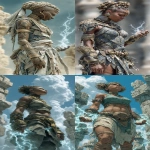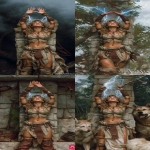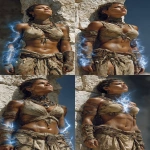Explore the Best AI Image Gallery

AI: The Artistic Revolution - Reimagining Graphic Design
The world of graphic design is undergoing a seismic shift, driven by the rapid advancements in artificial intelligence (AI). AI-powered tools are no longer futuristic concepts; they are actively reshaping how designers conceptualize, create, and deliver visual content. This revolution presents both exciting opportunities and complex ethical considerations that demand careful attention.
The Rise of AI-Powered Design Tools
AI is empowering graphic designers with an arsenal of innovative tools that streamline workflows and unlock new creative possibilities.
- Generative Design: Imagine sketching a rough idea, and AI algorithms transforming it into a polished, professional design within seconds. Generative design tools leverage machine learning to generate multiple design variations based on user inputs, offering designers a diverse range of options to choose from.
- AI-Assisted Image Editing: AI is revolutionizing image editing with intelligent features that automate tedious tasks. Imagine tools that can automatically remove backgrounds, enhance colors, or even suggest creative edits based on the context of the image.
- Typography Optimization: AI algorithms can analyze text content and suggest the most appropriate fonts, styles, and layouts to ensure readability and visual impact.
Practical Applications in Graphic Design
The applications of AI in graphic design are vast and constantly evolving:
- Branding and Logo Design: AI can assist in generating unique logo concepts based on brand values, target audience, and industry trends.
- Social Media Graphics: Create eye-catching visuals for social media platforms with AI-powered design tools that automatically adapt to different aspect ratios and platform guidelines.
- Marketing Materials: Generate professional brochures, flyers, and presentations with AI assistance, saving time and resources.
- Web Design: AI can help design intuitive and user-friendly websites by suggesting layouts, color schemes, and navigation structures.
Ethical Considerations in AI-Driven Design
While the potential of AI in graphic design is immense, its crucial to address the ethical considerations that accompany this technology:
- Bias and Fairness: AI algorithms are trained on vast datasets, which may contain biases that reflect societal prejudices. Its essential to ensure that AI-generated designs are inclusive and equitable.
- Copyright and Intellectual Property: The question of ownership arises when AI creates original content. Clear guidelines are needed to address copyright concerns in the context of AI-generated design.
- Transparency and Explainability: Its important to understand how AI algorithms arrive at their design decisions. Transparency and explainability can build trust and allow for human oversight.
The Future of AI in Graphic Design
The future of graphic design is inextricably linked with the continued evolution of AI. We can anticipate:
- More sophisticated generative design tools: AI will become even more adept at creating complex and nuanced designs, pushing the boundaries of creativity.
- Personalized design experiences: AI will enable designers to tailor their creations to individual preferences and needs.
- Collaboration between humans and AI: Designers and AI algorithms will work together as partners, leveraging each others strengths to achieve exceptional results.
Conclusion
AI is not replacing graphic designers; its empowering them with new tools and possibilities. By embracing this technology responsibly, designers can unlock a world of creative potential and shape the future of visual communication.
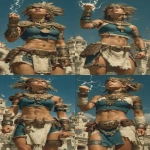












](https://images.ai-img.art/thumbnails/150/39c6bd41a1282b304a06fb11053bd009750b3879060719b1adb959228dbcd41a.webp)
](https://images.ai-img.art/thumbnails/150/33a7122c923d87ba243a3afa0b16a930f1603be27b8ac938ff7f4ae4f5140553.webp)
](https://images.ai-img.art/thumbnails/150/bc5b40f43007c984885fc5b035e0fd81d75554a8730895e067565a6b7050524b.webp)
](https://images.ai-img.art/thumbnails/150/00df9b84a8818b4130bce9ca10c0c67ff2bc8952ca0fb5012dafc9b1c6378e67.webp)






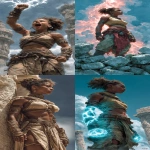










](https://images.ai-img.art/thumbnails/150/8aa2589b60ffe3dde30a265a6cac8d4ae71901c658ca48c4344f21436de413fb.webp)


